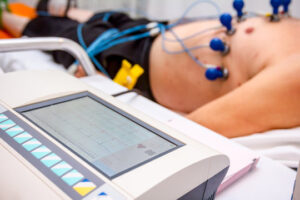An electrocardiogram (ECG) is a painless test that records the electrical activity of the heart. This test forms a part of your initial cardiac assessment. An ECG is a very useful tool for determining whether a person has heart disease or a heart attack. This test will assist in the evaluation of chest pain, difficulty in breathing, palpitations or any general concern about the hearts.
- Call at: (07) 5578 6866
- Email us: info@cardiacdynamics.com.au
ECG (Electrocardiograph)
How the Test is Performed
You will be asked to lie down. The nurse technician will apply suction electrode leads to our chest – thus avoiding the messy elctectrode gels and stick-ons It is usually unnecessary to shave or clip some hair to expose the skin.
The electrodes are connected wirelessly to a specialised computer that turns the heart’s electrical signals into wavy lines, which are electronically stored in your file. The test results are immediately interpreted by the computer and then confirmed by the doctor.
You will need to remain still during the procedure. Any movement, including muscle tremors such as shivering, can alter the results. So it is important to be relaxed and relatively warm during an ECG recording.

How to Prepare for the Test
Bring a list of your current medications with you to your appointment. This is important as some can alter the ECG recording. Exercising or drinking cold water immediately before an ECG may cause false results. Wear two-piece clothing and avoid wearing stockings.
How the Test Will Feel
An ECG is painless. No electricity is sent through the body. The electrodes may feel cold when first applied. In rare cases, some people may develop a rash or irritation where the patches were placed.
Why the Test is Performed
An ECG is used to provide information regarding:
- Any damage to the heart from blockages in your coronary arteries;
- How fast your heart is beating and whether it is beating normally;
- The effects of drugs or devices used to control the heart (such as a pacemaker); and
- The size and position of your heart chambers
